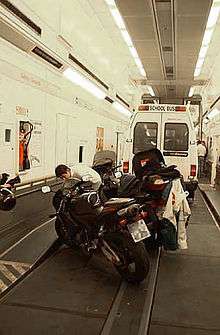Eurotunnel Shuttle

Eurotunnel Le Shuttle[1] (sometimes shortened to Le Shuttle or The Shuttle) is a shuttle service between Calais (Coquelles) in Nord-Pas-de-Calais, France and Folkestone, Kent in the United Kingdom. It conveys road vehicles by rail through the Channel Tunnel. Passenger and freight vehicles are carried in separate shuttle trains. All carriages have a stainless steel exterior.
The service is owned and operated by Eurotunnel, the Channel Tunnel owners.
Operation
The carriages used for the shuttle have a larger loading gauge than either British or French railways; consequently they cannot travel outside the tunnel and the two terminals at Coquelles and Folkestone. Each terminal is provided with a loop of track. After a train comes out of the tunnel, it travels around the loop and stops at the terminal platform. It is then unloaded, and re-loaded with a new set of vehicles to go through the tunnel. It then starts the return journey through the tunnel.
The loop at Folkestone is clockwise and is in a cut and cover tunnel, while the loop at Coquelles is anti-clockwise. This evens the wear on the wheels of the shuttle locomotives and vehicles, as each set (left or right) spends only half the time at the outer edge of the line traversing the corners.
Carriages

EuroTunnel Shuttles are 775 metres in length and are made from constructive stainless steel.[2]
Passenger vehicles
Passenger vehicles are carried in a car shuttle train, made up of closed wagons. Half of the train (the rear rake) carries cars and other low vehicles in double-deck wagons, with the first and last two carriages of the section containing the access ramps. Coaches, buses and other high vehicles travel in the single-deck rake at the front of the train. In busy times, cars can also use this section.
Driver and passengers may leave their vehicles and walk along the train to use the toilets, but there are no other services on board. Passengers have to stay in their cars or beside them, as the gradients in the tunnel mean that there are chances when vehicles could roll back and forth and strike someone.
Eurotunnel occasionally run the double deck carriages at "half full", closing the top deck to reduce costs.
The toilets are provided in every third carriage in the double-deck section, and in the first and last carriages in the single-deck section.
Freight vehicles
Lorries are carried on semi-open wagons with a lattice shell, with a separate passenger carriage at the front of the train for the drivers of the HGVs to have a small meal and relax. After drivers board the train in their lorry, they are taken to the "club car" by bus. This arrangement is a form of rolling highway, but operates over a much shorter distance than most rolling highways as the journey is only 35 minutes.
Safety
Safety regulations require two locomotives for all passenger trains through the tunnel (Shuttle and Eurostar), one at the front and one at the back, and both must be staffed so that the train can be reversed out in case of a blockage. (Each locomotive is capable of hauling the train on its own in the event that its partner fails. In the event that both locomotives fail, the next scheduled train and its two fully functioning locomotives has sufficient power to move both its own load and the disabled train through the tunnel.) There are also attendants. In the case of the freight vehicle shuttles, the attendants ride in the passenger carriage at the front of the train with the lorry drivers; in the passenger vehicle shuttles, they patrol the train.
Passenger vehicle carriages are sealed off with fireproof doors and are pressurised. These doors are closed once all vehicles are loaded. They include smaller pedestrian doors that may be opened when the train is in motion to move from one carriage to the next but then close automatically.
Eurotunnel has been criticised for failing to implement measures to prevent or extinguish fires in the open-framed large-goods-vehicle-carrying wagons; recommendations made by the Fire Brigade Union in 1996 following a fire in the Channel Tunnel that closed wagons should be used to prevent the spread of fire, were not acted upon.[3][4]
References
- ↑ "Eurotunnel homepage". Retrieved 5 April 2011.
- ↑ http://www.eurotunnel.com/build/
- ↑ Owen, Ed (18 September 2008). "Channel Tunnel fire made worse by open wagons". New Civil Engineer. Retrieved 14 January 2010.
- ↑ Jones, Sam (18 September 2008). "Eurotunnel did not follow safety recommendations made after previous blazes | Travel". The Guardian. London. Retrieved 14 January 2010.
External links
| Wikimedia Commons has media related to |